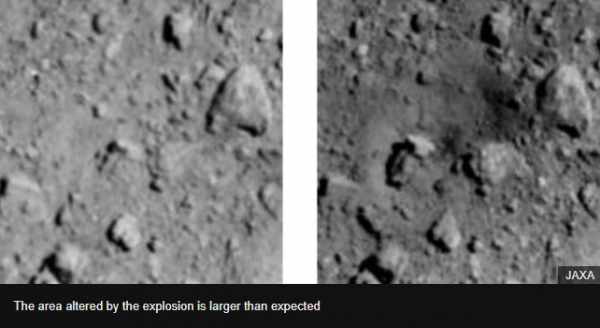Leaderboard
Popular Content
Showing content with the highest reputation on 27/04/19 in all areas
-
Whatever happens in the last two league games and the semis against Barca we can only be proud of this side. Yes, we need a trophy but this side couldn't have given any more to get that. We'd already be Champions in pretty much any other season. I hope we win one of them because this side deserves it. What a fucking football team2 points
-
@Bluewolf New episode of Warrior is out! And the series has already been renewed for Season Two1 point
-
Haha so Rosberg apparently is temporarily suspended from the paddock because he lent his personal pass to an unauthorised cameraman in Shanghai1 point
-
1 point
-
A Tremor on Mars Confirms a Lasting Suspicion Marina Koren Because we’ve been sitting on the same rock for thousands of years, sometimes our language can tend to be a little Earth-centric. The word earthquake, for example, feels universal, as if it can be applied to any shaking ground. But zoom out beyond our tectonic plates, and the vocabulary shifts. Mars, for instance, has marsquakes. They sound too silly to be real as if a Netflix show about future Mars settlements made up a scary natural disaster. But tremors on Mars are a thing, and right now scientists believe they have detected a quake on Mars for the first time. © NASA /JPL-Caltech / University of Arizona / Texas A&M Scientists know this because they sent a seismometer to our planetary neighbour. The instrument arrived last year, on board a NASA lander called InSight. The seismometer, small and dome-shaped, has sat on the brick-coloured surface since, waiting for hints of movement below the surface. On April 6, it caught something, a “quiet but distinct” signal, scientists said. A rumble from the depths. “We’ve been waiting months for our first marsquake,” Philippe Lognonné, a geophysicist at the Institute of Earth Physics of Paris who leads the seismometer team, said in a statement this week. Scientists have suspected for decades that they’d find this phenomenon if they had the right tools to look. Unlike Earth, Mars lacks tectonic plates that glide over its mantle, jostling the ground when they touch. But like Earth, Mars has three distinct layers—a rocky crust, a mantle, and a metal core—and it’s still cooling from its fiery formation out of a primordial cloud of cosmic dust. Even now, billions of years later, heat radiates from its centre and can be strong enough to crack the surface and escape. The fracturing sends seismic waves streaming in all directions. © Thomson Reuters An electric 4WD vehicle designed to represent a vehicle used for an imagined Mars exploration drives near the C-Space Project Mars simulation base in the Gobi Desert outside Jinchang, Gansu Province, China, April 18, 2019. REUTERS/Thomas Peter Marsquakes can help scientists study the interior of the planet. Seismic waves move like beams of light in a hall of mirrors; as they propagate throughout the planet, they bounce around. Different materials redirect the waves in different ways. Data from seismometers allow scientists to track the zigzagging of the waves and determine the composition of the stuff they strike. While scientists are thrilled about the detection, they wish the rumble were stronger. The quake measured about 2.5 on the Richter scale, too weak to draw a path within the depths. If a tremor like that happened on Earth, you wouldn’t feel it. If you were standing next to the InSight lander at the moment of detection, you wouldn’t know either. “We are waiting for the big, big one,” says David Mimoun, a scientist at France’s Higher Institute of Aeronautics and Space and a member of the seismometer team. Researchers expect to detect dozens more, some as powerful as 5.5 magnitude. The marsquake provided some information about the lander’s surroundings, though. It lasted 15 minutes, a relatively long time for such a weak rumble. This suggests that the ground beneath the InSight lander doesn’t have much water, which is known to exist on Mars mostly as ice. “When there is water, it dampens the quake,” Mimoun says. © Thomson Reuters An electric 4WD vehicle designed to represent a vehicle used for an imagined Mars exploration drives near the C-Space Project Mars simulation base in the Gobi Desert outside Jinchang, Gansu Province, China, April 18, 2019. REUTERS/Thomas Peter Some of the earliest missions to Mars sought to find evidence of marsquakes. A pair of Viking landers touched down on the surface in the 1970s with seismometers in tow. But the instruments were mounted on the spacecraft rather than set on the ground, and only one actually worked. Under these circumstances, it was difficult to tell whether rumblings originated from the depths or from the hardware shuddering against a strong wind. In 1976, a seismometer on one of the landers felt some shaking on a not-too-windy day. But the spacecraft recorded measurements of the wind speed only 20 minutes before the mysterious rumbling and 45 minutes after. Scientists couldn’t rule out a wind gust in that missing window. This time, they’re more certain. With the seismometer firmly on the ground, it’s easier to pick out the gusts from the tremors. “We’ve seen a lot of wind previously, and we know that this is something different,” says Ingrid Daubar, a scientist at NASA’s Jet Propulsion Laboratory and a member of the InSight team. © Thomson Reuters An installation representing a cave on Mars is seen at the C-Space Project Mars simulation base in the Gobi Desert outside Jinchang, Gansu Province, China, April 17, 2019. REUTERS/Thomas Peter While scientists have ruled out the wind as a potential cause, they haven’t fully investigated the possibility of a meteor impact, which can cause the surface to rumble. Daubar says the team will compare images of the InSight lander’s surroundings from before and after the detection and look for evidence of any fresh craters. Earth and Mars share their shaky properties with another celestial body: the moon. During the 1970s, seismometers placed on the lunar surface by Apollo astronauts detected hundreds of moonquakes. Some reached a magnitude of 5.5. Scientists suspect several sources, including churning in the moon’s interior caused by Earth’s gravitational tug. First, there’s a low, steady hum, the voice of the wind sweeping across the surface. Then, something higher pitched and urgent—the quake. At the end, the whirring of the lander’s robotic arm, manoeuvring to take pictures of the scene. The sound of the quake is the big draw here. But it’s the noise of the robotic arm, a hollow cooing, that is my favourite. To hear the vibrations of a quake on another planet is a beguiling experience. But the sound of the delicate movements of the machine that captured them, that humankind somehow managed to dream up and deliver to Mars in one piece, is somehow a little sweeter. https://www.msn.com/en-gb/news/techandscience/a-tremor-on-mars-confirms-a-lasting-suspicion/ar-BBWlb3A?li=AAnZ9Ug1 point
-
Hayabusa-2: Spacecraft's 'bomb' crater found The Hayabusa-2 spacecraft has sent back images of the crater made when it detonated an explosive charge next to the asteroid it is investigating. On 5 April, the Japanese probe released a 14kg device packed with plastic explosive towards the asteroid Ryugu. The blast drove a copper projectile into the surface, hoping to create a 10m-wide depression. Scientists want to get a "fresh" sample of rock to help them better understand how Earth and the other planets formed. Hayabusa-2 has now taken pictures of the area below where the "small carry-on impactor" (SCI) device was to have detonated and identified a dark disturbance in which fresh material has been excavated from beneath the surface. Scientists working on the Japanese Aerospace Agency (Jaxa) mission said the blast area on the surface measures about 20m in diameter - twice the size of the crater they expected to see. The mission's official account tweeted: "We did not expect such a big alteration, so a lively debate has been initiated in the project!" Because of the debris that would have been thrown up in this event, Hayabusa-2 manoeuvred itself before the detonation to the far side of 800m-wide Ryugu - out of harm's way and out of sight. But the probe left a small camera behind called DCAM3 to observe the explosion. Hayabusa-2 later returned to its "home position" about 20km above the asteroid's surface. From here, it conducted a search for the crater produced in the explosion. In coming weeks, scientists will command the probe to descend into the crater to collect its fresh samples. Because they will come from within the asteroid, they will be less altered by the harsh environment of space. Bombardment with cosmic radiation over the aeons is thought to change the surfaces of these planetary building blocks. Ryugu belongs to a particularly primitive type of space rock known as a C-type asteroid. It's a relic left over from the early days of our Solar System, and therefore records the conditions and chemistry of that time - some 4.5 billion years ago. https://www.bbc.co.uk/news/science-environment-480652821 point
-
Two episodes down and loving it. Even got the wife hooked which is a rarity so thanks for recommending.1 point







.thumb.png.e95369f6f827d2b46e5c24b0370d23b8.png)